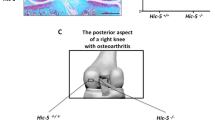Abstract
Objectives
To investigate the role of YAP in cyclic mechanical stress induced up-regulation of HIF-1α in rat cartilage chondrocytes.
Results
Our in vitro and in vivo experiments demonstrated that cyclic mechanical stress promoted HIF-1α and YAP proteins expression in a magnitude dependent manner. Cyclic mechanical stress at 4000μ strain exhibited most significant effect in promoting HIF-1α and YAP up-regulation. Activation of YAP using LPA significantly promoted HIF-1α stabilization and expression, while YAP siRNA treatment suppressed the up-regulation of HIF-1α induced by cyclic mechanical stress.
Conclusion
Our results indicated that cyclic mechanical stress promoted HIF-1α stabilization and YAP is involved in mechanical stress induced HIF-1α up-regulation.




Similar content being viewed by others
Data availability
All data generated or analysed during this study are included in this published article and its supplementary information files.
References
Amarilio R, Viukov SV, Sharir A et al (2007) Hif1alpha regulation of sox9 is necessary to maintain differentiation of hypoxic prechondrogenic cells during early skeletogenesis. Development 134:3917–3928
Bouaziz W, Sigaux J, Modrowski D et al (2016) Interaction of hif1alpha and beta-catenin inhibits matrix metalloproteinase 13 expression and prevents cartilage damage in mice. Proc Natl Acad Sci USA 113:5453–5458
Dupont S, Morsut L, Aragona M et al (2011) Role of yap/taz in mechanotransduction. Nature 474:179–183
Fernandez-Torres J, Martinez-Nava GA, Gutierrez-Ruiz MC et al (2017) Role of hif-1alpha signaling pathway in osteoarthritis: a systematic review. Rev Bras Reumatol Engl Ed 57:162–173
Ge L, Wang Y, Cao Y et al (2018) Mir-429 improved the hypoxia tolerance of human amniotic cells by targeting hif-1alpha. Biotechnol Lett 40:1477–1486
Iijima H, Ito A, Nagai M et al (2017) Physiological exercise loading suppresses post-traumatic osteoarthritis progression via an increase in bone morphogenetic proteins expression in an experimental rat knee model. Osteoarthr Cartil 25:964–975
Jing X, Ye Y, Bao Y et al (2018) Mechano-growth factor protects against mechanical overload induced damage and promotes migration of growth plate chondrocytes through rhoa/yap pathway. Exp Cell Res 366:81–91
Ma B, Chen Y, Chen L et al (2015) Hypoxia regulates hippo signalling through the siah2 ubiquitin e3 ligase. Nat Cell Biol 17:95–103
Pacary E, Tixier E, Coulet F et al (2007) Crosstalk between hif-1 and rock pathways in neuronal differentiation of mesenchymal stem cells, neurospheres and in pc12 neurite outgrowth. Mol Cell Neurosci 35:409–423
Provot S, Zinyk D, Gunes Y et al (2007) Hif-1alpha regulates differentiation of limb bud mesenchyme and joint development. J Cell Biol 177:451–464
Schipani E, Mangiavini L, Merceron C (2015) Hif-1alpha and growth plate development: what we really know. Bonekey Rep 4:730
Shi Y, Ma J, Zhang X et al (2015) Hypoxia combined with spheroid culture improves cartilage specific function in chondrocytes. Integr Biol (Camb) 7:289–297
Thompson CB (2016) Into thin air: how we sense and respond to hypoxia. Cell 167:9–11
Thoms BL, Dudek KA, Lafont JE et al (2013) Hypoxia promotes the production and inhibits the destruction of human articular cartilage. Arthritis Rheum 65:1302–1312
Torzilli PA, Bhargava M, Chen CT (2011) Mechanical loading of articular cartilage reduces il-1-induced enzyme expression. Cartilage 2:364–373
Yang K, Wu Y, Cheng P et al (2016) Yap and erk mediated mechanical strain-induced cell cycle progression through rhoa and cytoskeletal dynamics in rat growth plate chondrocytes. J Orthop Res 34:1121–1129
Zhong W, Tian K, Zheng X et al (2013) Mesenchymal stem cell and chondrocyte fates in a multishear microdevice are regulated by yes-associated protein. Stem Cells Dev 22:2083–2093
Supporting information
Supplementary Table 1—Primer sequences used in the quantitative Real-time PCR.
Supplementary Table 2—The target sequences of YAP siRNAs.
Funding
This work was supported by grants from the National Natural Science Foundation of China (Grant Nos. 81702155 and 81874020).
Author information
Authors and Affiliations
Corresponding authors
Ethics declarations
Conflict of interest
The authors declare that there are no conflicts of interest.
Additional information
Publisher's Note
Springer Nature remains neutral with regard to jurisdictional claims in published maps and institutional affiliations.
Electronic supplementary material
Below is the link to the electronic supplementary material.
Rights and permissions
About this article
Cite this article
Jing, X., Yang, X., Zhang, W. et al. Mechanical loading induces HIF-1α expression in chondrocytes via YAP. Biotechnol Lett 42, 1645–1654 (2020). https://doi.org/10.1007/s10529-020-02910-4
Received:
Accepted:
Published:
Issue Date:
DOI: https://doi.org/10.1007/s10529-020-02910-4




